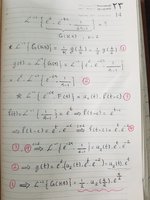I'm having trouble finding the inverse Laplace transform of \(\displaystyle \frac{e^2e^{-4s}}{2s-1}\). The book suggests using the identity \(\displaystyle \mathcal{L}^{-1}(F(ks))=\frac{1}{k}f(\frac{t}{k})\). Separating \(\displaystyle e^2\) out, I get \(\displaystyle e^2\mathcal{L}^{-1}(\frac{e^{-4s}}{2s-1})\). Letting \(\displaystyle F(s)=\frac{e^{-2s}}{s-1}\), I get \(\displaystyle e^2\mathcal{L}^{-1}(F(2s))\). Using the identity, the result should then be \(\displaystyle \frac{e^2}{2}u_2(\frac{t}{2})e^{\frac{t}{2}}\). However, the book says the correct solution is \(\displaystyle \frac{1}{2}e^{\frac{t}{2}}u_2(\frac{t}{2})\). The \(\displaystyle e^2\) appears to have magically disappeared somehow.
This is problem number 29 section 6.3 from Elementary Differential Equations and Boundary Value Problems 10th edition by William E. Boyce and Richard C. DiPrima published by Wiley.
This is problem number 29 section 6.3 from Elementary Differential Equations and Boundary Value Problems 10th edition by William E. Boyce and Richard C. DiPrima published by Wiley.
Last edited:

